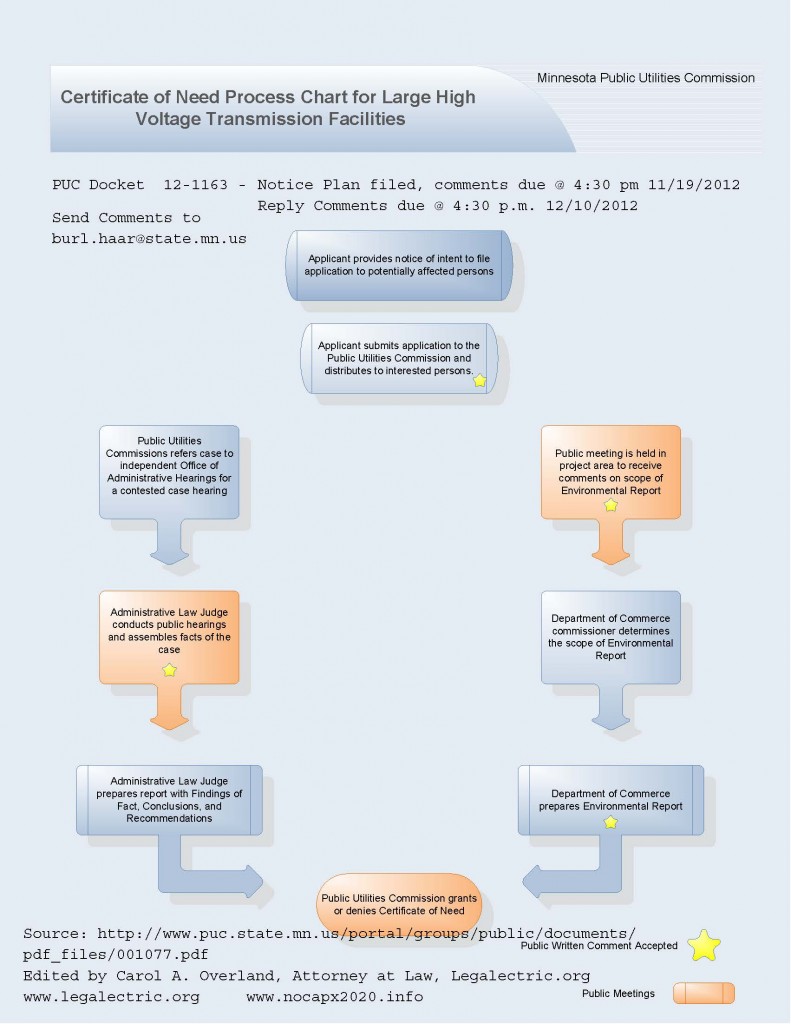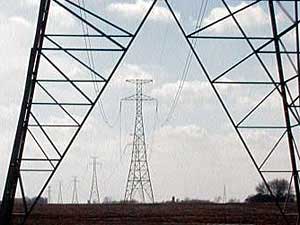Not-so-Great Northern Transmission Line Comments
January 16th, 2013
Comments were due today on Minnesota Power’s request for Exemptions from the rules governing content of Applications for a Certificate of Need for a transmission line.
Look at the red on that map — potentially affected areas where MP is looking to put a transmission line. WOOOOO-EEEE, that’s a lot of land!
Minnesota Power’s proposed Great Northern Transmission Line is inching along in the Certificate of Need process. Here’s Minnesota Power’s site:
And to look at the full docket, go to www.puc.state.mn.us, click on “Search eDockets” and search for 12-1163. The application is expected sometime in March or so, but I’d guess it will be later.
Here’s how they plan to let people know about the project — it was filed a while ago, Comments were due, and I tried and tried to get people to comment, oh well, here’s what was filed about the Notice Plan filed in October and the Comments filed in November:
That’s sitting at the PUC now. So where are we? Just starting out… Here’s a diagram of the hoops for the PUC process, edited a bit by yours truly for handouts at the meetings a couple months ago, we’re at the very first box in the chart:
Today, comments were due on the Minnesota Power request for Exemptions from some specific rules, Reply Comments, that is. Here’s what’s been filed:
Minnesota Power Exemption Request
ILSR’s Farrell on Fed Transmission Scam
June 29th, 2011
ILSR’s John Farrell is halfway there – he recognizes the federal part of the transmission equation, but the state part is missing, for example, Minnesota’s special eminent domain exemptions for “Public Service Corporations” (particularly where the transmission is for private profit, NOT public service), rate recovery for “Construction Work in Progress” and state regulators refusal to examine the interstate nature of transmission proposals. And the third part of that unholy trinity — in the Midwest, bulk power transmission would not be being built but for the Settlement Agreement – ME3(Fresh Energy), Izaak Walton League (and Walton’s program Wind on the Wires), Minnesota Center for Environmental Advocacy, and North American Water Office. This glut of transmission is their legacy. It takes all three to build transmission.
From Grist, today:
Feds running a high-voltage gravy train for power transmission
by John Farrell
28 Jun 2011 6:00 AM
Even as distributed generation shows economical and political advantages over centralized renewable energy, the Federal Energy Regulatory Commission (FERC) is running a high voltage gravy train in support of expanded transmission. FERC’s lavish program is expanding large transmission infrastructure at the expense of ratepayers instead of looking at more economical alternatives.Since 2007, FERC has had 45 requests for bonus incentives for transmission development — authorized under the 2005 Energy Policy Act — and has provided all or most of the requested incentives in more than 80 percent of the cases. With the bonuses, the average return on equity for utilities for their new transmission investments is nearly 13 percent. This high rate of return is a full 2.5 percentage points higher than the median utility return on equity [PDF], a value considered just and reasonable by state public service commissions in ordinary times. However, these rewards came during a time when unemployment doubled, the stock market tumbled, and most corporations were lucky to have any profit.The ratepayer impact of these bonuses is significant. In a November 2010 criticism of FERC transmission awards, Commissioner John Norris noted that the 2 percent bonus FERC provided to the PATH high-voltage project on the Eastern seaboard would “cost [Maryland] ratepayers in PJM at least $18 million per year.” The bonus payments were also given in concert with other incentives that reduced risk, including rate recovery during construction and guarantee of payment if the facilities were abandoned for reasons outside utility control.
Transmission in NYT today
February 7th, 2009
Matthew Wald has a good piece in the NYT today, good in that it raises some of the issues, but these issues raised need some more digging, can you dig it?
Check this paragraph from the article:
In fact, energy experts say that simply building a better grid is not enough, because that would make the cheap electricity that comes from burning coal available in more parts of the country. That could squeeze out generators that are more expensive but cleaner, like those running on natural gas. The solution is to put a price on emissions from dirtier fuels and incorporate that into the price of electricity, or find some other way to limit power generation from coal, these experts say.
Not “could,” but WOULD “squeeze out generators that are more expensive but cleaner” and adding externalities to coal generation cost would only stop that, would only be a “solution” if it tacked on HUGE costs, far greater than those anticipated by those advocating either Cap & Trade or Tax.
But those of us in transmission are glad to see the driver for new construction exposed, as it was in the MISO Benefits Study by our good friends at ICF:
RTO operational benefits are largely associated with the improved ability to displace generation with coal generation, more efficient use of coal generation, and better use of import potential.
Here’s that MISO study, the above quote comes from the conclusions, p. 83, and is also stated in the intro — THIS IS THE REASON FOR TRANSMISSION, THIS IS THE REASON FOR THE MIDWEST MISO MARKET. Read the study:
ICF’s Independent Assessment of Midwest ISO Operational Benefits
For example, Jose Delgado whining about hwo long it took to get the permit for Arrowhead, what does he expect for a project that was an absurdly obvious ploy for a superhighway for bulk power portrayed as a “local load” need for WUMS? They put together many options in the WRAO report, and selected one, Arrowhead, “3j,” as the be-all and end-all of transmission. That was declared the ONE line that would fix Wisconsin. Then, next thing you know, they still want to do “5” more commonly known as the Chisago project, they want to do “9” in SW Minnesota claiming “it’s for wind” when there’s only 213-302MVA coming off of Buffalo Ridge into the Nobles substation, they do them all because that’s what they want, they can ship bulk power. It’s been so dishonest… Utilities have been so dishonest…
And let’s look at the financing of these lines. CapX 2020 testimony and a powerpoint demonstrate that they don’t have the financing lined up for that $2 billion dollar project. They were working through Lehman Bros. so what does that say? The “Cap” of CapX 2020 is “Capital” and they don’t have it. But because they want it, they’ll make us pay for it. Is something wrong with this picture?
———————————————–
Hurdles (Not Financial Ones) Await Electric Grid Update
“We burn up three years on a line that will take two months to build,” he said.


